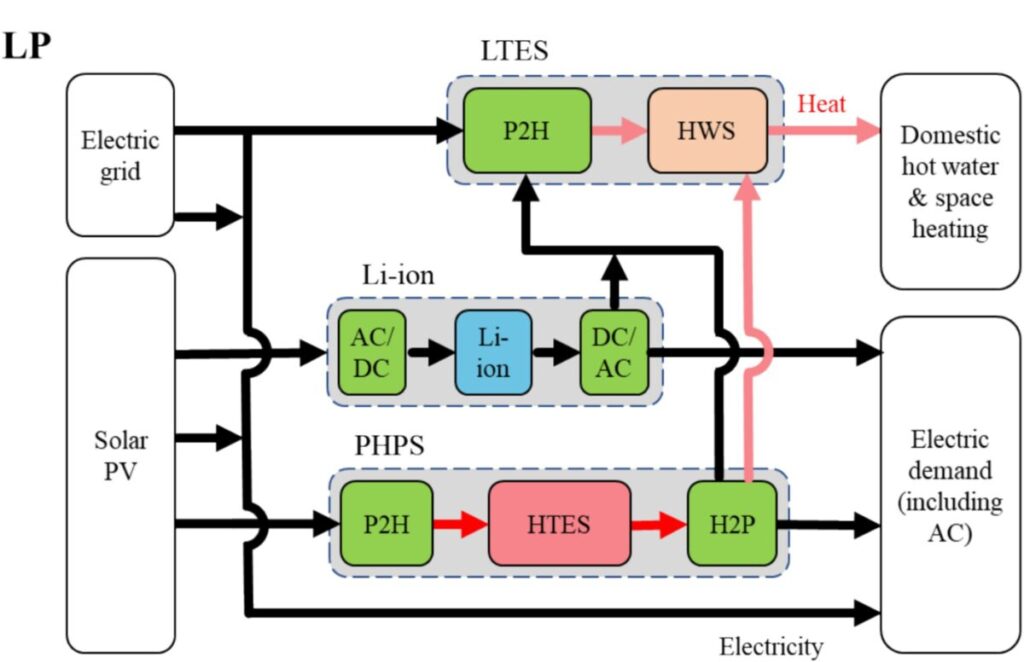Scientists in Spain have simulated a system that uses both Power-to-Hit-to-Power Thermal batteries and lithium ion batteries for energy storage. The hybrid system is said to have reached a 7% lower LCOE compared to a PV system that depends exclusively on lithium batteries, while at the same time the PV self-consumption increased by a maximum of 20%.
Researchers from the Spain’s Technical University of Madrid have designed a hybrid system that combines PV, lithium-ion (Li-ion) batteries, power-to-heat-to-Power thermal batteries (PHPs) and heat pumps.
“The high capital costs per unit of energy storage of Li-ion batteries often result in systems with relatively small storage capacities, which leads to low self-consumption relationships,” the group explained. “Thermal batteries with power generation capacity, such as PHPs, use the considerably lower costs of thermal energy storage to increase the total storage capacity of the system. Moreover, PHPS systems generate heat as a by-product during the energy conversion, which can be used directly in the building to provide the demand for heating.”
The research team simulated a fully electrified building via PVsyst and EnergyPlus, with price and weather data that are relevant to Madrid.
The PHPs and Li-ion (LP system) include PV panels, Li-ion battery system, energy storage with low temperature (LTEs) and PHPS system. The latter included a power-to-heat (P2H) converter, high temperature energy storage (HTEs) and a heat-to-power (H2P) converter.
A reference L system without the PHPS unit was used for comparison. Both systems were tested with an electric heater with a performance bosses (COP) of 1 or a heat pump with an agent of 2.7.
“The priorities of the energy use for the LP system are (1) electricity demand is prioritized to be met by PV generation, followed by the PHPS system, and finally by the Li-ion battery; (2) heating demand is preferentially covered by the LTES, then by PV, PHPS, and finally Li-ion; (3) when There is A Surplus of PV Generation, this is preferably used to charge the li -ion battery, then the phps, and finally the ltes. Every remaining PV generation is injected into the grid without compensation, “the academics explained. “That also applies to the L-System configuration, where the PHPs are removed.”
Image: Universidad Politécnica de Madrid, Applied Energy, CC by 4.0
The annual total energy demand of the system was set to 20 MWh, where the demand for electricity is good for 4 MWh and the demand for a heating for 16 MWh. The lifespan of all technologies in the configuration was supposed to be 25 years, with the costs per current capacity of PV € 800 ($ 910.2)/kW. The weighted average capital costs were supposed to be 4%and inflation was set at 2%.
Through their analysis, the research team discovered that hybridization of Li-ion batteries with a cheap PHPS system is generally preferred over a single Li-ion battery installation, regardless of variations in the costs and COP of the heat pump. Moreover, they have established that the low costs per energy and import capacity of the PHPS system make it ideal for storing high peak power when generating PV and providing the demand for basic tax on longer periods. “On the contrary, the optimum Li-ion battery specializes in supplying a high peak demand to shorter duration,” they explained further.
The scientists also discovered that the level of energy costs (LCOE) for an LP system with a heat pump was € 76/MWH, while it was € 147/MWH for an LP system with an electric heating. For comparison: the L system with a heat pump had an LCOe of € 77/MWh and of € 149/MWh when using an electric stove. The optimum size of the PV unit was 7 kW for the L system with heat pump and 10 kW for all other systems.
The PV-self-consumption speed turned out to be 68.3% in the LP housing with the heat pump, 68.1% for the L-housing with the heat pump, 79.5% for the LP system with an electrical heating and 68.6% for the L-system with an electric stove.
“According to the assumptions of this study, the hybrid solution reduces the empty costs of consumed energy by 7% compared to a system that is exclusively dependent on Li-ion batteries, while at the same time the PV-self-consumption increases by a maximum of 20%,” the group concluded.
The hybrid system was presented in “Integration of lithium-ion and thermal batteries with heat pumps for improved photovoltaic self-consumption“Published in Applied energy.
This content is protected by copyright and may not be reused. If you want to work with us and reuse part of our content, please contact: editors@pv-magazine.com.
Popular content


